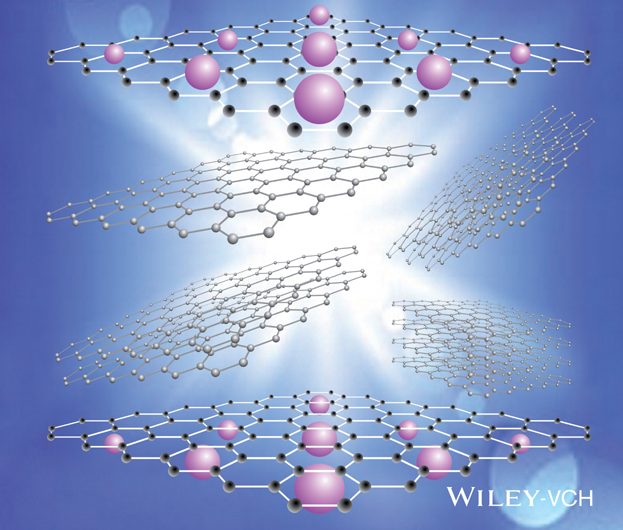Redefining Graphite

We all know pencils and have worked with them. Graphite is a very inexpensive material known for many years for manufacturing pencils. It is 2016 in Yachay Tech and Julio Chacon talks about the properties of intercalated graphite with other compounds. More than 30 years ago in 1980, Professor Mildred Dresselhaus was the first one to thoroughly analyze and study the properties of this material. She noted the possibility of creating intercalation compounds with graphite and found that these materials have very interesting optical and electronic properties. Thereafter, a very interesting research area on this material and its intercalation compounds began. Since 2008, Julio Chacon has been studying these compounds to deepen the understanding of its optic/electronic properties and practical applications.
But what is an intercalation compound? In this case, the term refers to combinations of graphite with other elements of the periodic table. In 1980, Prof. Dresselhaus mixed alkali metals (potassium, lithium, cesium, and rubidium) with graphite and the first thing she noticed was a change in color. Graphite, from black, turned blue, red and finally golden. The color change depends on the concentration of the metal in the collation: blue when there is less metal and gold when the metal is more concentrated within the atomic structure of graphite (this is known as intercalation).
What Dresselhaus did was very interesting in the 80’s, but then other materials were discovered such as nanotubes, fullerenes and more recently, graphene, so these intercalation compounds with graphite were not so interesting anymore at the time. However, in 2005 it was discovered that mixing graphite with calcium resulted in a superconducting material, which means that there is no resistance to electron flows: it can be used to conduct electricity without any resistance and no loss. This is when the research done in the 80’s resumed to determine why these materials are superconductors and the relation between this behavior with their optical and electronic properties.
Also, they began making other intercalation compounds using fullerenes and carbon nanotubes. In principle, this is what drew Julio Chacon into Professor Dresselhaus’ work, as it was developed by the ones who then became his doctoral supervisors. When Julio joined the research group at the University of Vienna (Austria) in 2010, his supervisor asked him to replicate the experiments conducted in the 80’s to see if there were any properties that had not yet been found –20 years later, with current tools that brought more possibilities and allowed you to find something that had not been previously found. And so it was, Julio found behaviors that had not been reported before, which depended greatly on how atoms were mixed in the graphite structure.
However, this wasn’t what had the biggest impact. When graphene was discovered, it became a very attractive material for technological and mechanical applications. However, one of its main problems is that it is very expensive to produce. A chemistry group came up with the idea to decompose graphite, mixing it with alkali metals (intercalation) to produce graphene at a lower cost and in large quantities. A new research line was then opened, which makes using graphite with intercalated compounds even more interesting.
Julio is currently working with a research group in Germany trying to produce graphene sheets that are very pure and of very high quality by using graphite intercalated compounds. This process is not only convenient but cost-efficient. This is Julio’s field of work at the moment. He is looking to produce graphene that is more affordable and in larger quantities but also to study the properties of graphene intercalated with alkaline metals. All this is possible thanks to the versatility of the carbon-hybridization process, which is the main component of graphite.
Carbon is an element that can donate or absorb electrons, depending on which element it pairs with. This is what we call hybridization. Another hybridization process is the one that it has with itself. It can form bonds strong enough to form diamonds, for instance. Diamonds have a hybridization process known as sp3, (each carbon atom is bonded to four other carbon atoms).There is also the sp2 hybridization, which forms graphene. When graphite bonds with alkali metals, there is an electronic hybridization, meaning that there are no chemical bonds, but that electrons of each atom bind together. That is what causes the superconducting properties of graphite and graphene.
Julio left Mexico more than 7 years ago. He studied mechatronics engineering at Tecnológico de Monterrey. It was the first time that this career was taught in León Guanajuato, so he was recommended to look for a specialization as soon as he finished his program. Julio graduated in 2008 and went on to study nanotechnology at the IPICyT (Potosino Institute of Scientific and Technological Research).Two years later, he attended a conference in Canada and met his doctoral supervisor. He was offered a European scholarship to Vienna, where he obtained his PhD in Materials Physics in three years, and specialized in the study of optical and electronic properties of nanomaterials as graphite, graphene, and carbon nanotubes.
Then he obtained his PhD and did a postdoc at the Free University of Berlin with funding from the Marie Curie Foundation and the Free University of Berlin, since he won a project contest. This allowed him to develop his own line of research and manage the funds intended for his research expenses. He carried out his research in Berlin and had very good results: several publications, out of which some have already been published while others are still in the process of being published.
This gave Julio Chacón the opportunity to join Yachay Tech where he currently works as assistant professor, which means that he will be able to start his own research team. Not only does Julio want to provide an excellent training to Physics and Nanotechnology students but he is also interested in creating a world-renowned research group like the ones he met where he worked.